Windows of Opportunity
I remember once being shown an apartment by a New York realtor. The apartment was in an elegant prewar building, with a living room so big that I could have held ballroom dancing classes there. But out of the large living room windows, the view looked onto a brick wall and the looming windows of the opposite neighbor eight feet away. Peering through the glass, I could read the titles of the books on that neighbor’s shelves. If I’d taken the apartment, the neighbor’s life would have been a background movie shadowing my days.
Many city dwellers live this way. The proximity of strangers in the city, and the voyeuristic impulses it brings out in people, have given rise to some memorable works of art. The great cultural touchstone is, of course, Hitchcock’s Rear Window , but other works in the genre include Edward Hopper’s Nighthawks , Michael Wolf’s The Transparent City and Merry Alpern’s Dirty Windows , an uber-voyeuristic study of the goings-on in a neighboring brothel’s window.
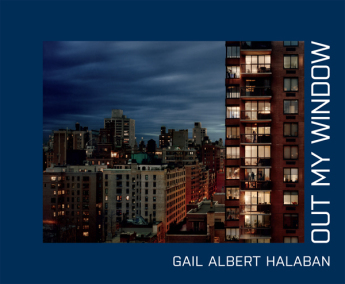 A new and welcome addition to the genre is
Out My Window
, an elegiac love song to New York City by photographer
Gail Albert Halaban
. Unlike some of her predecessors, Albert Halaban doesn’t focus on the isolation and loneliness of city dwellers. Her vision is more expansive, allowing for moments of joy and connection along with the typical urban anomie. Glimpsed through her windows are friends sharing stories, families eating dinner and people looking out for the welfare of their neighbors.
A new and welcome addition to the genre is
Out My Window
, an elegiac love song to New York City by photographer
Gail Albert Halaban
. Unlike some of her predecessors, Albert Halaban doesn’t focus on the isolation and loneliness of city dwellers. Her vision is more expansive, allowing for moments of joy and connection along with the typical urban anomie. Glimpsed through her windows are friends sharing stories, families eating dinner and people looking out for the welfare of their neighbors.
The images look spontaneous at first, and you wonder how Albert Halaban caught such perfect moments. In fact, though the subjects are in their real environments, the images are planned in advance. Each one involves extensive scouting, permissions, planning and remote contact by walkie-talkie.
Despite some differences in its emotional tone, Out My Window has been frequently compared to Edward Hopper’s paintings. Intrigued by the comparison, Albert Halaban recently embarked on a project to re-photograph some of the sites of Hopper’s paintings. The quest took her to Gloucester, Massachusetts, a seaside town where Hopper painted intensively over several summers in the 1920s. The Literate Lens talked to her about both of these projects.
Literate Lens: What was your inspiration for Out My Window?
Gail Albert Halaban: It’s related to my previous work, which focused on women in their environments. I’ve always been interested in people and their personal spaces, and in getting intimate views of them. When I started this project I didn’t quite realize the connection, but it’s there.
LL: Why did you decide to get permission and collaborate with your subjects?
GAH: As a photographer and a human being, I just think it’s important that subjects know they’re being photographed. That’s especially true when it’s in people’s apartments, where they have a reasonable expectation of privacy. Photography can be an aggressive medium. Rather than shooting a person, I like to be collaborating in making a picture.
LL: It definitely makes for a warmer feeling in the images. Is that something you wanted?
GAH: Yes. The project is partly about community building. I’m interested in the fact that people who wouldn’t otherwise meet have met their neighbors through this project. I’ve made a lot of friends too. You don’t get that if you’re just stealing someone’s picture through a window.
LL: Were you communicating with your subjects while you shot?
GAH: Yes. I was on a walkie-talkie with them, or a cellphone. I was using a 4 x 5-inch view camera, which is very slow, so I had to have some very patient subjects. I wanted the images to be moments that a casual observer might see if they looked into a window, like someone preparing dinner or a mom hugging her kid. Of course, they were heavily directed and posed to be those kinds of moments!
LL: What was the most people you were talking to for any single image?
GAH: The image on the cover of the book is the most complex, I was communicating with five apartments. But there were some moments of total serendipity too. In one image, of a woman in a bathrobe looking at a construction site opposite her window, a builder suddenly appeared on the scaffold as I was shooting and stared at us. That was one of the best moments!
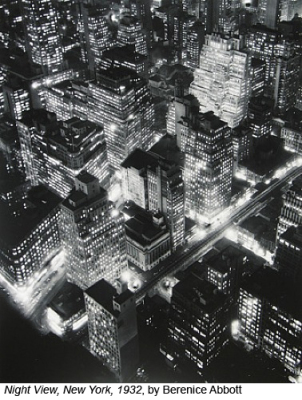 LL: Looking at your images, I thought a lot about Berenice Abbott’s famous photograph ‘Night View.’
LL: Looking at your images, I thought a lot about Berenice Abbott’s famous photograph ‘Night View.’
GAH: Oh, she’s my major, major influence. Obviously, anyone who photographs the city lit up at night references her. She’s also the first person I can find who photographed the city from above ground. Her production was so detailed, she timed everything so perfectly.
LL: Right. In order to capture ‘Night View’ she could only photograph on the shortest day of the year, and she had a 45-minute window when office lights would still be lit up as dusk was falling. You photograph a lot at dusk too…
GAH: Yes, for the same reason: it’s a time of day you can see into windows but still see the buildings around them. I like how light changes at different times of day and changes your perception of forms, but dusk is always an amazing time to see into windows.
LL: People have also likened your work to Edward Hopper’s paintings…
GAH: Hopper brilliantly depicted loneliness in the city. But I’m interested in the push-pull between being alone/lonely, and being part of a bigger community. In New York we’re surrounded by people, so even if we’re lonely we’re never truly alone. Interestingly, my pictures were used to illustrate an article on loneliness in New York magazine, and I felt that was so not what my work was about!
LL: You got sufficiently interested in Hopper that you went to Gloucester, Massachusetts and re-photographed some of the sites of his paintings. Did that change your perception of him?
GAH: Absolutely, yes. When I studied Hopper in college, all my professors said he wasn’t a true realist, that he worked a lot from imagination. In Gloucester, it was crazy how similar the sites were to his actual paintings. He became a modernist in Gloucester and changed details of light, color and form, but the paintings are still very true.
LL: Other photographers, like Gregory Crewdson, have acknowledged a debt to Hopper.
GAH: Gregory was my professor at Yale. He and I see Hopper very differently. I’m a mom, and my work is very much connected to that. I’m interested in everyday moments—a mom hugging her kid, a dad setting the table—whereas Gregory is more about making the moment as psychological and dramatic as he can. It’s interesting that we can both take Hopper and go in completely different directions with it.
LL: Who are your other influences?
GAH: Helen Leavitt is really important to me. There’s a lyricism to her pictures, and she connected with and identified with so many people. She photographs the city like it’s her living room. Also, Nan Goldin and Tina Barney. I’m interested in family life and connection, and–I know this is old-fashioned–I still believe photography can communicate an honest, real truth. Then formally, I’m interested in Mondrian, who uses color to create a sense of movement and rhythm in the city. One image I took, near the High Line in Chelsea, recalls Mondrian to me.
LL: Out My Window is a book now, but do you have other plans for it?
GAH: I do. I’m soon going to be taking this project global. From New York, I’ll be remotely directing camera operators in other countries through Skype to photograph through their windows. They’ll be using high-end equipment and I’ll be directing the lighting, so the images will be as similar as possible to the ones in the book. In future, I hope to give the project a bigger digital presence. In the meantime I’m very open to anyone, anywhere in the world telling me where there’s an interesting view out of the window!
————————————————————-
Visit Gail Albert Halaban’s Web site here .
Read an article about her project re-photographing Edward Hopper sites here .
See a slide show of her Hopper photographs and the original paintings here .
See another interview with her here
3 comments on “ Windows of Opportunity ”
Leave a Reply
Connecting to %s

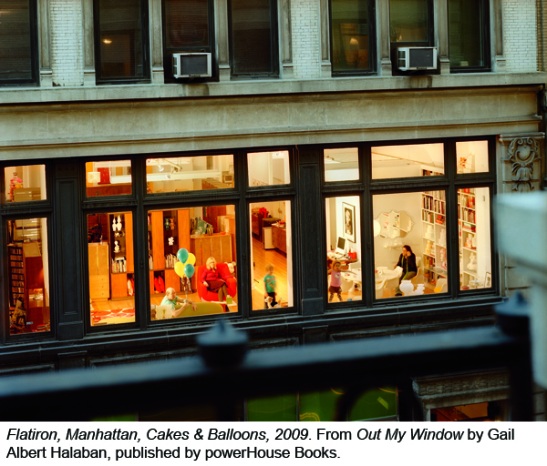
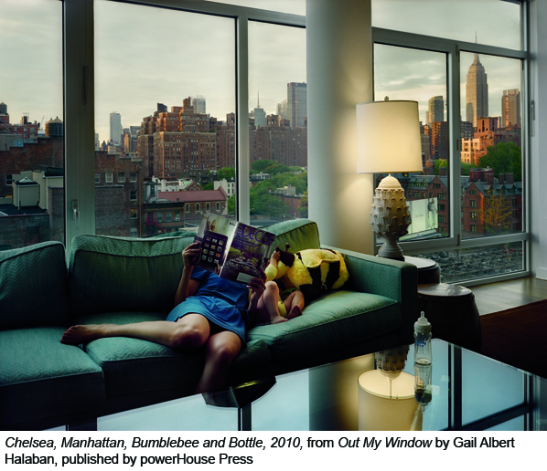
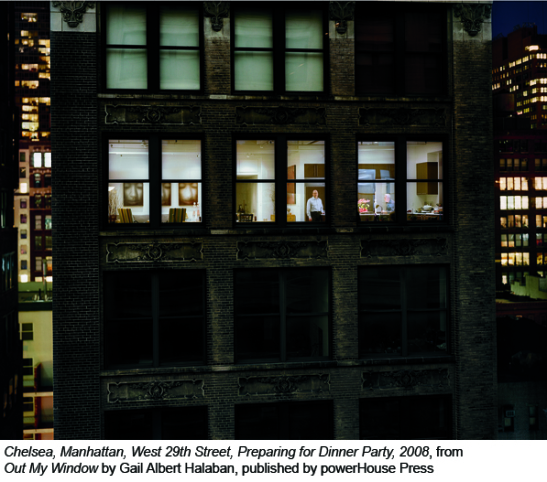
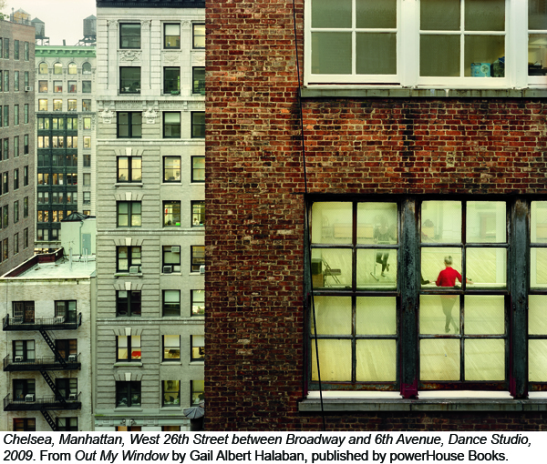
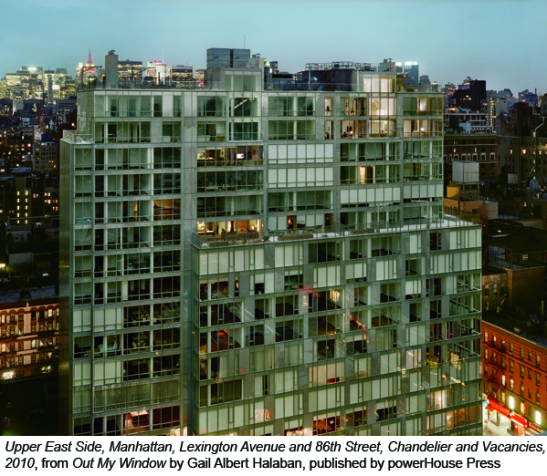
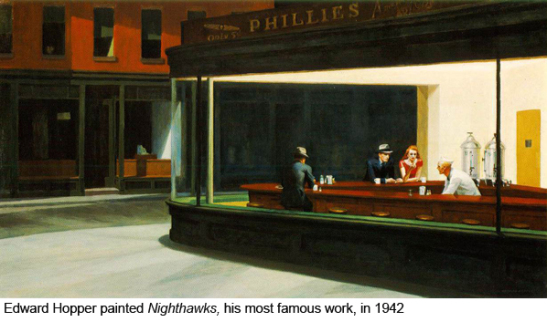
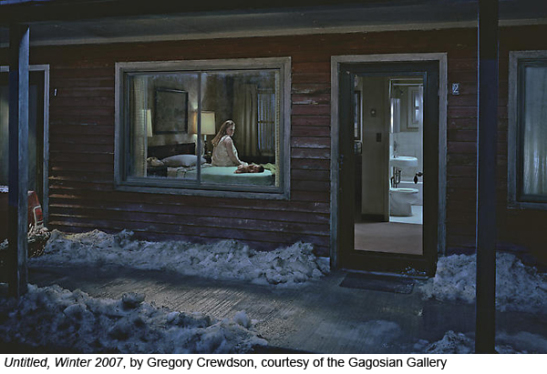
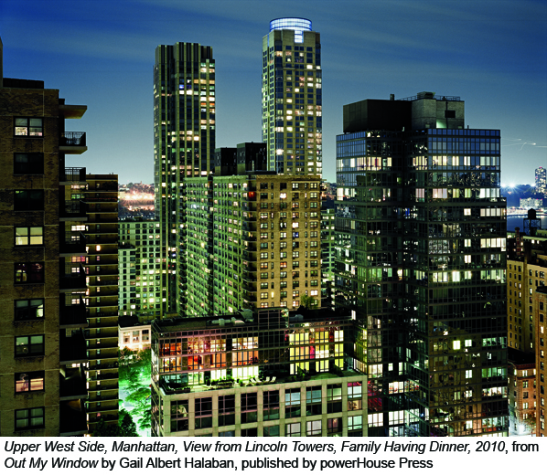

Another corker! How do you get all the material for these blogs? It was very interesting, particularly all the references to other artists. Well done. Love, Mum Vera Coleman vrcoleman@btinternet.com
Fascinating body of work and a great interview.
Great stuff, Sarah!
Gail Halaban’s technique is fascinating, but as your article reveals is based on a lot of hard work.
I liked the view of the dance studio best. There used to be a Fred Astaire Dance Studio near where we usually stay in NYC and in the evening one could see the dancers from the opposite side of Broadway. As you couldn’t hear the music, it was like a coloured silent movie. An eerie sensation, just like Hopper’s paintings and Halaban’s photographs.
Love from Michael